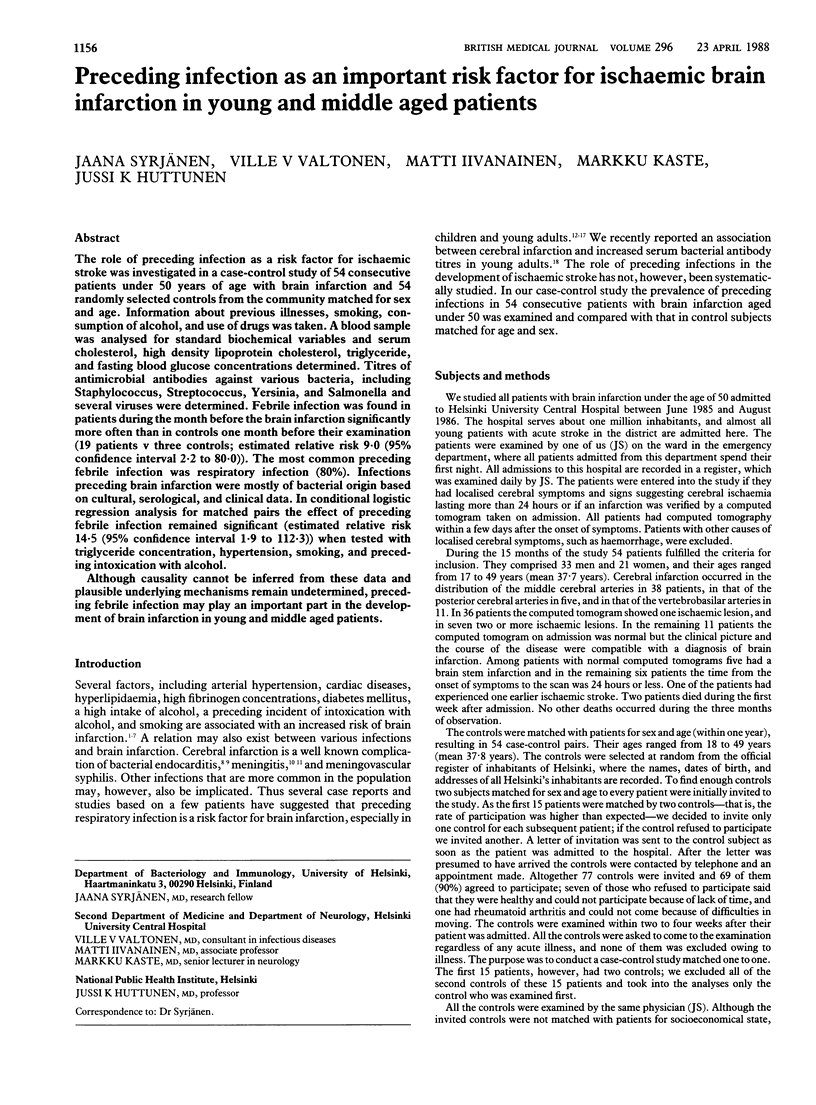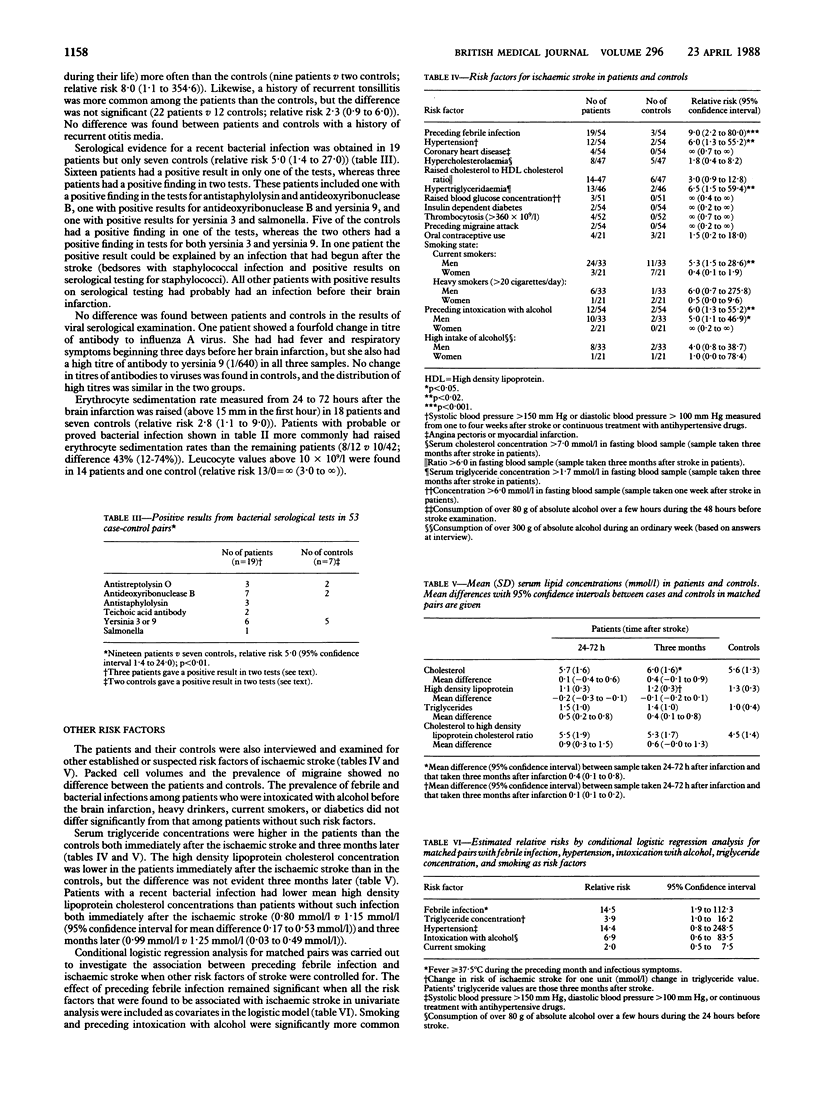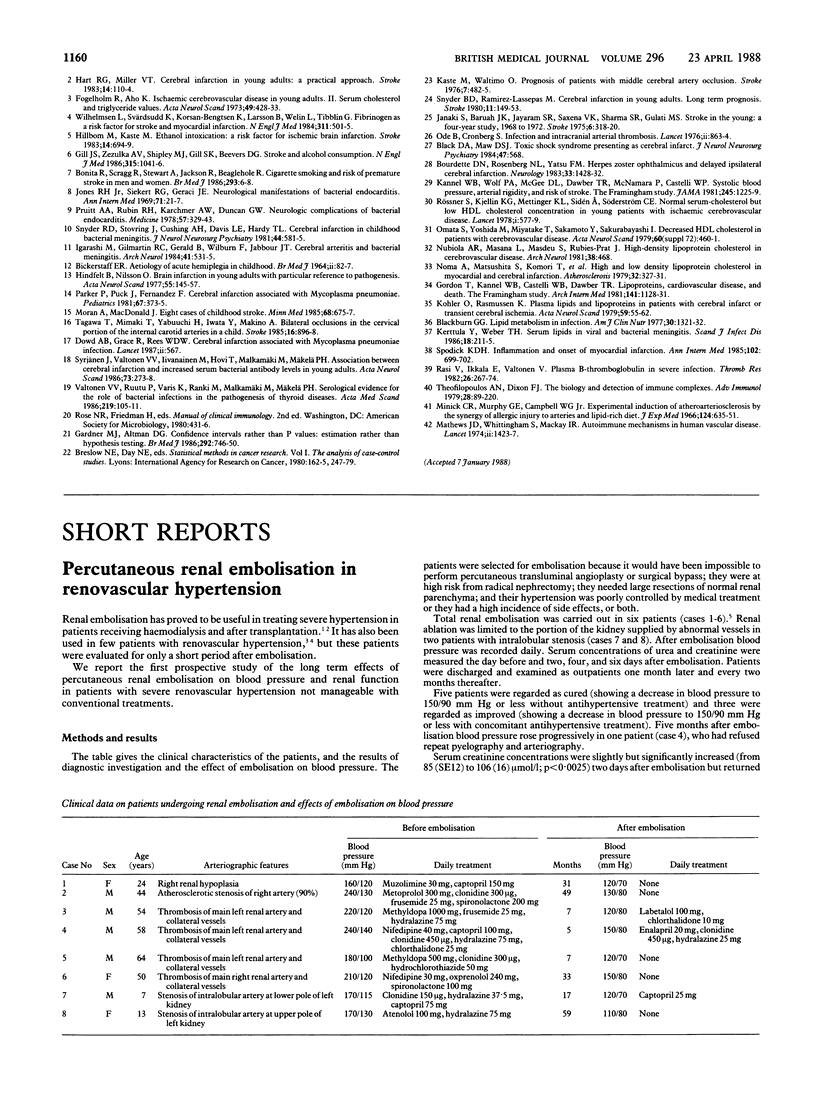Abstract
The role of preceding infection as a risk factor for ischaemic stroke was investigated in a case-control study of 54 consecutive patients under 50 years of age with brain infarction and 54 randomly selected controls from the community matched for sex and age. Information about previous illnesses, smoking, consumption of alcohol, and use of drugs was taken. A blood sample was analysed for standard biochemical variables and serum cholesterol, high density lipoprotein cholesterol, triglyceride, and fasting blood glucose concentrations determined. Titres of antimicrobial antibodies against various bacteria, including Staphylococcus, Streptococcus, Yersinia, and Salmonella and several viruses were determined. Febrile infection was found in patients during the month before the brain infarction significantly more often than in controls one month before their examination (19 patients v three controls; estimated relative risk 9·0 (95% confidence interval 2·2 to 80·0)). The most common preceding febrile infection was respiratory infection (80%). Infections preceding brain infarction were mostly of bacterial origin based on cultural, serological, and clinical data. In conditional logistic regression analysis for matched pairs the effect of preceding febrile infection remained significant (estimated relative risk 14·5 (95% confidence interval 1·9 to 112·3)) when tested with triglyceride concentration, hypertension, smoking, and preceding intoxication with alcohol.
Although causality cannot be inferred from these data and plausible underlying mechanisms remain undetermined, preceding febrile infection may play an important part in the development of brain infarction in young and middle aged patients.
Full text
PDF




Selected References
These references are in PubMed. This may not be the complete list of references from this article.
- BICKERSTAFF E. R. AETIOLOGY OF ACUTE HEMIPLEGIA IN CHILDHOOD. Br Med J. 1964 Jul 11;2(5401):82–87. doi: 10.1136/bmj.2.5401.82. [DOI] [PMC free article] [PubMed] [Google Scholar]
- Black D. A., Maw D. S. Toxic shock syndrome presenting as cerebral infarct. J Neurol Neurosurg Psychiatry. 1984 May;47(5):568–568. doi: 10.1136/jnnp.47.5.568. [DOI] [PMC free article] [PubMed] [Google Scholar]
- Blackburn G. L. Lipid metabolism in infection. Am J Clin Nutr. 1977 Aug;30(8):1321–1332. doi: 10.1093/ajcn/30.8.1321. [DOI] [PubMed] [Google Scholar]
- Bonita R., Scragg R., Stewart A., Jackson R., Beaglehole R. Cigarette smoking and risk of premature stroke in men and women. Br Med J (Clin Res Ed) 1986 Jul 5;293(6538):6–8. doi: 10.1136/bmj.293.6538.6. [DOI] [PMC free article] [PubMed] [Google Scholar]
- Bourdette D. N., Rosenberg N. L., Yatsu F. M. Herpes zoster ophthalmicus and delayed ipsilateral cerebral infarction. Neurology. 1983 Nov;33(11):1428–1432. doi: 10.1212/wnl.33.11.1428. [DOI] [PubMed] [Google Scholar]
- Dowd A. B., Grace R., Rees W. D. Cerebral infarction associated with Mycoplasma pneumoniae infection. Lancet. 1987 Sep 5;2(8558):567–567. doi: 10.1016/s0140-6736(87)92950-3. [DOI] [PubMed] [Google Scholar]
- Fogelholm R., Aho K. Ischaemic cerebrovascular disease in young adults. 2. Serum cholesterol and triglyceride values. Acta Neurol Scand. 1973;49(4):428–433. doi: 10.1111/j.1600-0404.1973.tb01315.x. [DOI] [PubMed] [Google Scholar]
- Gardner M. J., Altman D. G. Confidence intervals rather than P values: estimation rather than hypothesis testing. Br Med J (Clin Res Ed) 1986 Mar 15;292(6522):746–750. doi: 10.1136/bmj.292.6522.746. [DOI] [PMC free article] [PubMed] [Google Scholar]
- Gill J. S., Zezulka A. V., Shipley M. J., Gill S. K., Beevers D. G. Stroke and alcohol consumption. N Engl J Med. 1986 Oct 23;315(17):1041–1046. doi: 10.1056/NEJM198610233151701. [DOI] [PubMed] [Google Scholar]
- Gordon T., Kannel W. B., Castelli W. P., Dawber T. R. Lipoproteins, cardiovascular disease, and death. The Framingham study. Arch Intern Med. 1981 Aug;141(9):1128–1131. [PubMed] [Google Scholar]
- Hart R. G., Miller V. T. Cerebral infarction in young adults: a practical approach. Stroke. 1983 Jan-Feb;14(1):110–114. doi: 10.1161/01.str.14.1.110. [DOI] [PubMed] [Google Scholar]
- Hillbom M., Kaste M. Ethanol intoxication: a risk factor for ischemic brain infarction. Stroke. 1983 Sep-Oct;14(5):694–699. doi: 10.1161/01.str.14.5.694. [DOI] [PubMed] [Google Scholar]
- Hindfelt B., Nilsson O. Brain infarction in young adults (with particular reference to pathogenesis). Acta Neurol Scand. 1977 Feb;55(2):145–157. doi: 10.1111/j.1600-0404.1977.tb05635.x. [DOI] [PubMed] [Google Scholar]
- Igarashi M., Gilmartin R. C., Gerald B., Wilburn F., Jabbour J. T. Cerebral arteritis and bacterial meningitis. Arch Neurol. 1984 May;41(5):531–535. doi: 10.1001/archneur.1984.04050170077022. [DOI] [PubMed] [Google Scholar]
- Janaki S., Baruah J. K., Jayaram S. R., Saxena V. K., Sharma S. H., Gulati M. S. Stoke in the young: a four-year study, 1968 to 1972. Stroke. 1975 May-Jun;6(3):318–320. doi: 10.1161/01.str.6.3.318. [DOI] [PubMed] [Google Scholar]
- Jones H. R., Jr, Siekert R. G., Geraci J. E. Neurologic manifestations of bacterial endocarditis. Ann Intern Med. 1969 Jul;71(1):21–28. doi: 10.7326/0003-4819-71-1-21. [DOI] [PubMed] [Google Scholar]
- Kannel W. B., Wolf P. A., McGee D. L., Dawber T. R., McNamara P., Castelli W. P. Systolic blood pressure, arterial rigidity, and risk of stroke. The Framingham study. JAMA. 1981 Mar 27;245(12):1225–1229. [PubMed] [Google Scholar]
- Kaste M., Waltimo O. Prognosis of patients with middle cerebral artery occlusion. Stroke. 1976 Sep-Oct;7(5):482–485. doi: 10.1161/01.str.7.5.482. [DOI] [PubMed] [Google Scholar]
- Køhler O., Rasmussen K. Plasma lipids and lipoproteins in patients with cerebral infarct or transient cerebral ischemia. Acta Neurol Scand. 1979 Mar;59(2-3):55–62. doi: 10.1111/j.1600-0404.1979.tb02911.x. [DOI] [PubMed] [Google Scholar]
- Mathews J. D., Whittingham S., Mackay I. R. Autoimmune mechanisms in human vascular disease. Lancet. 1974 Dec 14;2(7894):1423–1427. doi: 10.1016/s0140-6736(74)90077-4. [DOI] [PubMed] [Google Scholar]
- Minick C. R., Murphy G. E., Campbell W. G., Jr Experimental induction of athero-arteriosclerosis by the synergy of allergic injury to arteries and lipid-rich diet. I. Effect of repeated injections of horse serum in rabbits fed a dietary cholesterol supplement. J Exp Med. 1966 Oct 1;124(4):635–652. doi: 10.1084/jem.124.4.635. [DOI] [PMC free article] [PubMed] [Google Scholar]
- Moran A., MacDonald J. Eight cases of childhood stroke. Minn Med. 1985 Sep;68(9):675–677. [PubMed] [Google Scholar]
- Noma A., Matsushita S., Komori T., Abe K., Okabe H., Kuramoto K., Murakami M. High and low density lipoprotein cholesterol in myocardial and cerebral infarction. Atherosclerosis. 1979 Mar;32(3):327–331. doi: 10.1016/0021-9150(79)90176-x. [DOI] [PubMed] [Google Scholar]
- Nubiola A. R., Masana L., Masdeu S., Rubiés-Prat J. High-density lipoprotein cholesterol in cerebrovascular disease. Arch Neurol. 1981 Jul;38(7):468–468. doi: 10.1001/archneur.1981.00510070102026. [DOI] [PubMed] [Google Scholar]
- Ode B., Cronberg S. Infection and intracranial arterial thrombosis. Lancet. 1976 Oct 16;2(7990):863–864. doi: 10.1016/s0140-6736(76)91264-2. [DOI] [PubMed] [Google Scholar]
- Parker P., Puck J., Fernandez F. Cerebral infarction associated with Mycoplasma pneumoniae. Pediatrics. 1981 Mar;67(3):373–375. [PubMed] [Google Scholar]
- Pruitt A. A., Rubin R. H., Karchmer A. W., Duncan G. W. Neurologic complications of bacterial endocarditis. Medicine (Baltimore) 1978 Jul;57(4):329–343. doi: 10.1097/00005792-197807000-00004. [DOI] [PubMed] [Google Scholar]
- Rasi V., Ikkala E., Valtonen V. Plasma beta-thromboglobulin in severe infection. Thromb Res. 1982 May 15;26(4):267–274. doi: 10.1016/0049-3848(82)90291-2. [DOI] [PubMed] [Google Scholar]
- Rössner S., Kjellin K. G., Mettinger K. L., Sidén A., Söderström C. E. Normal serum-cholesterol but low H.D.L.-cholesterol concentration in young patients with ischaemic cerebrovascular disease. Lancet. 1978 Mar 18;1(8064):577–579. doi: 10.1016/s0140-6736(78)91026-7. [DOI] [PubMed] [Google Scholar]
- Snyder R. D., Stovring J., Cushing A. H., Davis L. E., Hardy T. L. Cerebral infarction in childhood bacterial meningitis. J Neurol Neurosurg Psychiatry. 1981 Jul;44(7):581–585. doi: 10.1136/jnnp.44.7.581. [DOI] [PMC free article] [PubMed] [Google Scholar]
- Spodick D. H. Inflammation and the onset of myocardial infarction. Ann Intern Med. 1985 May;102(5):699–702. doi: 10.7326/0003-4819-102-5-699. [DOI] [PubMed] [Google Scholar]
- Syrjänen J., Valtonen V. V., Iivanainen M., Hovi T., Malkamäki M., Mäkelä P. H. Association between cerebral infarction and increased serum bacterial antibody levels in young adults. Acta Neurol Scand. 1986 Mar;73(3):273–278. doi: 10.1111/j.1600-0404.1986.tb03275.x. [DOI] [PubMed] [Google Scholar]
- Theofilopoulos A. N., Dixon F. J. The biology and detection of immune complexes. Adv Immunol. 1979;28:89–220. doi: 10.1016/s0065-2776(08)60800-7. [DOI] [PubMed] [Google Scholar]
- Valtonen V. V., Ruutu P., Varis K., Ranki M., Malkamäki M., Mäkelä P. H. Serological evidence for the role of bacterial infections in the pathogenesis of thyroid diseases. Acta Med Scand. 1986;219(1):105–111. doi: 10.1111/j.0954-6820.1986.tb03283.x. [DOI] [PubMed] [Google Scholar]
- Wilhelmsen L., Svärdsudd K., Korsan-Bengtsen K., Larsson B., Welin L., Tibblin G. Fibrinogen as a risk factor for stroke and myocardial infarction. N Engl J Med. 1984 Aug 23;311(8):501–505. doi: 10.1056/NEJM198408233110804. [DOI] [PubMed] [Google Scholar]


